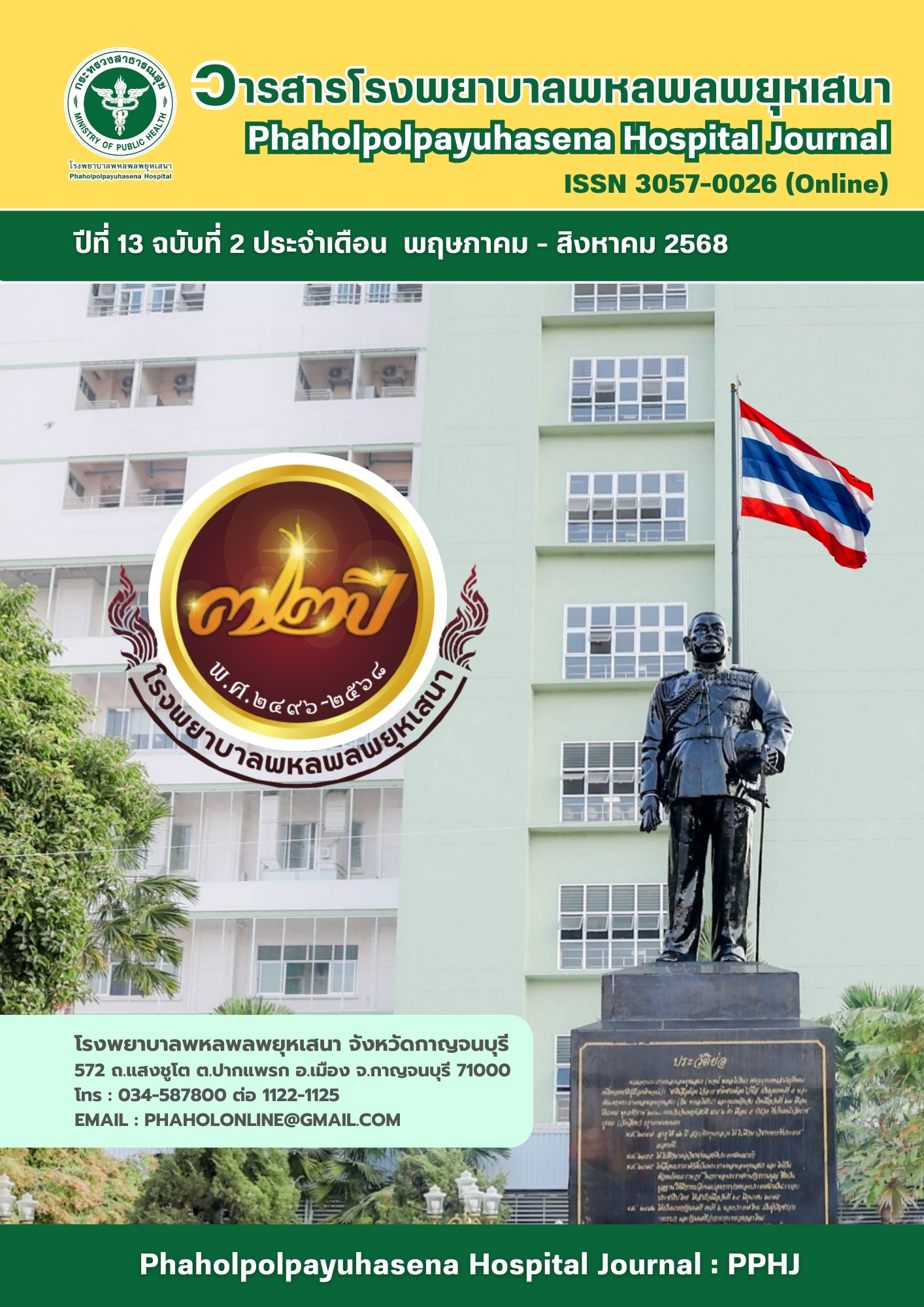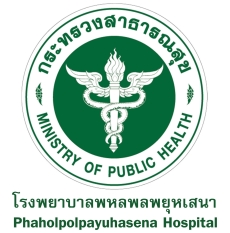เปรียบเทียบอาการคันจากการใช้มอร์ฟีนทางไขสันหลังปริมาณ 0.1 และ 0.2 มิลลิกรัม ในการผ่าตัดคลอดที่โรงพยาบาลพหลพลพยุหเสนา : การทดลองแบบสุ่มที่มีกลุ่มควบคุม
คำสำคัญ:
ผ่าตัดคลอด, ยามอร์ฟีนทางไขสันหลัง, อาการคัน, อาการคลื่นไส้อาเจียน, อาการปวดบทคัดย่อ
วัตถุประสงค์: เพื่อเปรียบเทียบอุบัติการณ์อาการคัน อาการคลื่นไส้อาเจียน และอาการปวด ระหว่างกลุ่มที่ได้รับยามอร์ฟีนทางไขสันหลังขนาด 0.1 มิลลิกรัม และ 0.2 มิลลิกรัม ในหญิงตั้งครรภ์ที่ผ่าตัดคลอดโดยการระงับความรู้สึก ทางไขสันหลัง
วิธีการศึกษา: เป็นการวิจัยเชิงทดลองแบบสุ่มและมีกลุ่มควบคุม ปกปิดสองฝ่ายและไปข้างหน้าในหญิงตั้งครรภ์ที่รับการผ่าคลอดแบบไม่เร่งด่วนโดยการระงับความรู้สึกทางไขสันหลังที่โรงพยาบาลพหลพลพยุหเสนา ระหว่างเดือนกุมภาพันธ์–เมษายน 2568 จำนวน 72 ราย แบ่งกลุ่มด้วยการสุ่มแบบบล็อก กลุ่มละ 36 ราย เปรียบเทียบอุบัติการณ์อาการคันและอาการคลื่นไส้อาเจียน และคะแนนปวดเฉลี่ยในช่วงเวลา 0–2, 2–12 และ 12–24 ชั่วโมงหลังได้รับยา วิเคราะห์ข้อมูลด้วยการทดสอบไค-สแควร์และการทดสอบค่าทีแบบเป็นอิสระต่อกัน
ผลการศึกษา: อุบัติการณ์อาการคันระหว่างกลุ่มไม่มีความแตกต่างกันทั้ง 3 ช่วงเวลา (ร้อยละ 2.78, 52.78, 30.56 และร้อยละ 11.11, 69.44, 38.89 ตามลำดับ) แต่มีแนวโน้มลดลงในกลุ่ม 0.1 มิลลิกรัม อุบัติการณ์คลื่นไส้อาเจียนในช่วง 12–24 ชั่วโมง กลุ่มที่ได้ยา 0.1 มิลลิกรัม ลดลงอย่างมีนัยสำคัญ (ร้อยละ 0 และ 13.89; p=0.020) ค่าเฉลี่ยคะแนนปวดและการได้รับยาแก้ปวดระหว่างทั้งสองกลุ่มไม่แตกต่างกัน
สรุปผล: การลดขนาดยาเหลือ 0.1 มิลลิกรัม แม้ไม่ลดอาการคันอย่างมีนัยสำคัญ แต่ช่วยลดอาการคลื่นไส้อาเจียนในช่วง 12–24 ชั่วโมงได้ชัดเจน โดยไม่กระทบต่อประสิทธิภาพในการบรรเทาอาการปวด จึงอาจเป็นทางเลือกที่ช่วยลดผลข้างเคียงได้โดยไม่ลดทอนผลการรักษา
เอกสารอ้างอิง
Kumar K, Singh SI. Neuraxial opioid-induced pruritus: An update. Journal of Anesthesiology Clinical Pharmacology. 2013;29(3):303–7.
Becker LM, Teunissen AJW, Koopman JS. Prevention and treatment of neuraxial morphine-induced pruritus: A scoping review. Journal of Pain Research. 2022;15:1633–45.
Cardoso MM, Carvalho JC, Amaro AR, Prado AA, Cappelli EL. Small doses of intrathecal morphine combined with systemic diclofenac for postoperative pain control after cesarean delivery. Anesth Analg. 1998;86(3):538–41.
Sarvela J, Halonen P, Soikkeli A, Korttila K. A double-blinded, randomized comparison of intrathecal and epidural morphine for elective cesarean delivery. Anesth Analg. 2002;95(2):436–40.
Thay YJ, Goh QY, Han RN, Sultana R, Sng BL. Pruritus and postoperative nausea and vomiting after intrathecal morphine in spinal anesthesia for caesarean section: Prospective cohort study. Proceedings of Singapore Healthcare. 2018;27(4):251–5.
Szarvas S, Harmon D, Murphy D. Neuraxial opioid-induced pruritus: a review. Journal of Clinical Anesthesia. 2003;15(3):234–9.
Palmer Craig M, Emerson S, Volgoropolous D, Alves D. Dose-Response Relationship of Intrathecal Morphine for Postcesarean Analgesia. Anesthesiology. 1999;90(2):437–44.
Gerancher JC, Floyd H, Eisenach J. Determination of an Effective Dose of Intrathecal Morphine for Pain Relief After Cesarean Delivery. Anesth Analg. 1999;88(2):346–51.
Girgin NK, Gurbet A, Turker G, Aksu H, Gulhan N. Intrathecal morphine in anesthesia for cesarean delivery: dose-response relationship for combinations of low-dose intrathecal morphine and spinal bupivacaine. Journal of Clinical Anesthesia. 2008;20(3):180–5.
Uchiyama A, Nakano S, Ueyama H, Nishimura M, Tashiro C. Low dose intrathecal morphine and pain relief following caesarean section. International Journal of Obstetric Anesthesia. 1994;3(2):87–91.
จีระนาถ ศรีวรมาศ, วิมลมาน ว่องไว, ญาณินทร สมเนตร. การศึกษาเปรียบเทียบอาการคันระหว่างการใช้มอร์ฟีน 0.1 มิลลิกรัมและ 0.2 มิลลิกรัม เข้าช่องนํ้าไขสันหลัง สําหรับการผ่าตัดคลอดในโรงพยาบาลสรรพสิทธิประสงค์ จังหวัดอุบลราชธานี. วิสัญญีสาร. 2013;39(3):171–182.
Jacobs NF, Veronese LR, Okano S, Hurst C, Dyer RA. The incidence of postoperative nausea and vomiting after caesarean section in patients with hyperemesis gravidarum: a retrospective cohort study. International Journal of Obstetric Anesthesia. 2020;44:81–9.
Dahl JB, Jeppesen IS, Jørgensen H, Wetterslev J, Møiniche S. Intraoperative and Postoperative Analgesic Efficacy and Adverse Effects of Intrathecal Opioids in Patients Undergoing Cesarean Section with Spinal Anesthesia. Anesthesiology. 1999;91(6):1919–27.
Aly M, Ibrahim A, Farrag W, Abdelsalam K, Mohamed H, Tawfik A. Pruritus after intrathecal morphine for cesarean delivery: incidence, severity and its relation to serum serotonin level. International Journal of Obstetric Anesthesia. 2018;35:52–6.
Abboud TK, Dror A, Mosaad P, Zhu J, Mantilla M, Swart F, et al. Mini-dose intrathecal morphine for the relief of post-cesarean section pain: safety, efficacy, and ventilatory responses to carbon dioxide. Anesth Analg. 1988;67(2):137–43.
Milner AR, Bogod DG, Harwood RJ. Intrathecal administration of morphine for elective Caesarean section: a comparison between 0.1 mg and 0.2 mg. Anaesthesia 1996;51(9):871–3.
Orarat Karnjanawanichkul, Jatuporn Pakpirom, Thitiporn Pueaksuwan, Sasikaan Nimmaanrat, Niranuch Siripunt, Sukanya Keawsridam. Different Doses of Intrathecal Morphine on Postoperative Analgesia and Pruritus after Cesarean Section: a Prospective Randomized Triple-Blinded Trial. PSU Medical Journal. 2022;2(3):109–20.
Abouleish EI, Rashid S, Haque S, Giezentanner A, Joynton P, Chuang AZ. Ondansetron versus placebo for the control of nausea and vomiting during Caesarean section under spinal anaesthesia. Anaesthesia. 1999;54(5):479–82.
Inthigood N, Lertbunnaphong T, Jaishuen A. Efficacy of a single 40-mg intravenous dose of parecoxib for postoperative pain control after elective cesarean delivery: A double-blind randomized placebo-controlled trial. Journal of Obstetrics and Gynaecology Research. 2016;43(1):92–9.
ดาวน์โหลด
เผยแพร่แล้ว
รูปแบบการอ้างอิง
ฉบับ
ประเภทบทความ
สัญญาอนุญาต
ลิขสิทธิ์ (c) 2025 โรงพยาบาลพหลพลพยุหเสนา

อนุญาตภายใต้เงื่อนไข Creative Commons Attribution-NonCommercial-NoDerivatives 4.0 International License.
บทความที่ได้รับการตีพิมพ์เป็นลิขสิทธิ์ของโรงพยาบาลพหลพลพยุหเสนา
ข้อความที่ปรากฏในบทความแต่ละเรื่องในวารสารวิชาการเล่มนี้เป็นความคิดเห็นส่วนตัวของผู้เขียนแต่ละท่านไม่เกี่ยวข้องกับโรงพยาบาลพหลพลพยุหเสนาและบุคลากรท่านอื่น ๆ ในโรงพยาบาลฯ แต่อย่างใด ความรับผิดชอบองค์ประกอบทั้งหมดของบทความแต่ละเรื่องเป็นของผู้เขียนแต่ละท่าน หากมีความผิดพลาดใด ๆ ผู้เขียนแต่ละท่านจะรับผิดชอบบทความของตนเอง





